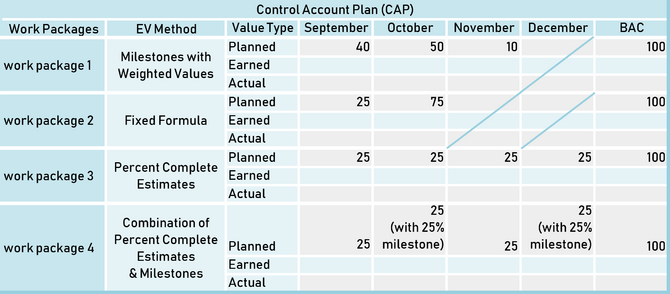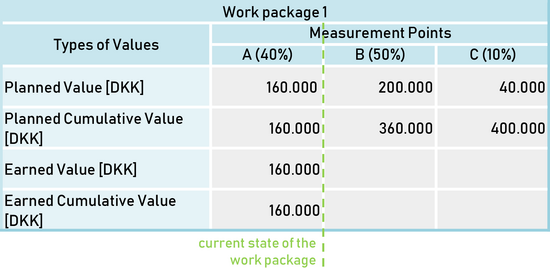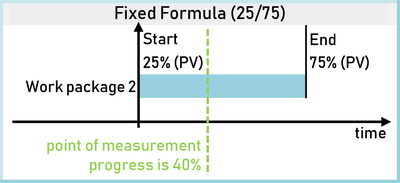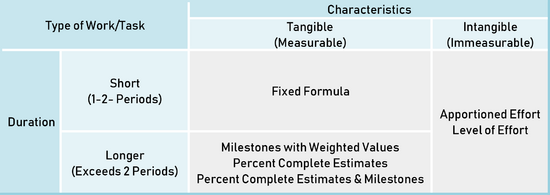Determining Measurement Methods in Earned Value Management
(→Milestones with Weighted Values) |
(→Annotated Bibliography) |
||
| (One intermediate revision by one user not shown) | |||
| Line 121: | Line 121: | ||
==Annotated Bibliography== | ==Annotated Bibliography== | ||
| − | + | *'''PMI PMBOK® Guide – Sixth Edition (2017)''' | |
| + | The PMI standard for project management introduces the earned value management in general (pp.105.), but lacks the detailed description of the practice. It contains information about the importance and benefits of earned value analysis (therefore it is useful to get an overview of the practice), but in order to implement it into real practice further examination is required. | ||
| + | *'''PMI Practice Standard for Earned Value Management – Second Edition (2011)''' | ||
| + | This practice standard for earned value management aims to give the previously desired examination, namely the detailed description of the practice with all of its topics and steps. Besides it gives a more accurate introduction to the process (Chapter 1, pp.5-12.), it also places the topic of the article into the various steps of EVM (Chapter 7, pp.35-43.). Furthermore, it defines the inputs and output of the measurement process, the explanation of the different methods with illustrations for a better understanding, and then ends with recommendations of the usage of the methods. | ||
| + | *'''Fleming, Q. and Koppelman, J. (2010). Earned value project management - Fourth Edition.''' | ||
| + | This book is for the same purpose than the previous standard, which is the description of earned value management but in even more details. In chapter 9 (pp.85-108.), more methods used to plan and measure earned value are discussed along with examples. It also provides information about Control Account Plans that helps to get an overview of the methods and their usage in the real world. | ||
==References== | ==References== | ||
<references /> | <references /> | ||
Latest revision as of 11:47, 4 March 2019
Developed by Veronika Zsuzsanna Bankó
Contents |
[edit] Abstract
Earned Value Management (EVM) is one amongst the many types of techniques which can be used to perform monitoring and controlling activities in project management. However, due to its complexity, it includes several topics and steps, i.e. organising project, assigning responsibility, developing schedule and so on. [1]
Overall, it is a very large topic to be discussed in a relatively short article, therefore this document first of all provides a brief description of the EVM technique. As it does not give a detailed insight into the EVM itself, it is highly recommended to be familiar with this management technique (precise information can be acquired about the EVM here: Earned Value Analysis). Then it aims to give a clear picture of one particular step from the whole process, namely the determination of different methods for measuring the project performance, and the selection strategy of choosing the most valuable and applicable one for the project. It itemizes the necessary inputs of the measurement and shows various outputs that could be gathered from the calculations. The main part of the article begins with the description of Control Account Plan, which is followed by several classes of work introduced, i.e. the discrete effort, the apportioned effort and the level of effort. In the class of discrete effort certain measurement methods (fixed formula, weighted milestone, percent complete, etc.) are presented in details involving their advantages and disadvantages. Each method is also illustrated with an example to show the elementary steps in practice. Guidelines are provided in the end of the article, with which the ability to choose the best suited measurement technique for a particular project is given.
[edit] Introduction to EVM
In project management, one of the most important sessions is the process of monitoring and controlling projects. The project manager is responsible for tracking the project's progress and performance with the help of predefined methods in terms of time and costs spent, and to analyze the value of work performed, in order to find out whether the current state of the project corresponds to the original project management plan. The main benefit of this task is, besides the accomplished insight into the health of the project, the ability to make corrective and preventive steps towards the successful completion of the project. [2]
EVM is one amongst the many types of techniques which can be used to perform these activities. EVM analysis with the usage of the predefined work scope, timeframe for performance of the work, resources and costs, etc. as inputs can be resulted in the so called “earned value”.[2] Earned value (EV) is the variable that shows the value of the work performed in a specific point of the time. It is then compared with the planned value (PV), that represents the initially planned schedule position, and the actual spent resources in order to show the current cost position.[3] The conclusion regarding the actual status of the project can be acquired after the comparison, which is a useful output for the management in order to determine the essential further modifications, such as corrective action plans. Furthermore, the forecast of expected project costs can be initially created and then updated. [2] To be able to measure the performance through the project’s duration, specific measurement points are needed. These dedicated control points are included in the Control Account Plan (CAP).
[edit] Control Account Plan (CAP)
According to Fleming et al. (2010) [3], Control Account Plan is "the fundamental building block which forms the project’s measurement baseline". It contains all the planned information which is needed in order to perform the monitoring process, that is to say the measurement of the actual status of work throughout the project. The necessary informations are, as listed by Fleming et al. (2010) [3]:
- Statement of work: brief scope description
- Schedule: start and stop dates for each task
- Budget
- Responsible person
- Responsible department
- Type of effort
- Division into discrete work packages
- Method used to measure earned value performance
The CAP is created before the progress of determination of measurement methods, because apart this all of the above elements are necessary inputs of the determination process, described in the following section.

As can be seen in Figure 1, a CAP consists of work packages, to which different EV measurement methods are assigned. Throughout the predefined timescale (in this example: 3 months), dedicated planned value control points are stated (example: one per month, but it could also be one per week). When the measurement takes place, the calculated earned value is compared with these points. It can also be acknowledged that each work package has different measurement methods assigned which raises some questions:
- What is the difference between these methods?
- How is one method assigned to a specific work package?
- How are the planned value control points calculated?
The Measurement Methods section strives to give a detailed answer to these concerns.
[edit] Inputs of the Measurement Process
The PMI Practice Standard for Earned Value Management [2] categorizes the inputs into the following list.
- Requirements documentation:
They are all documentation containing requirements which are relevant to the actual phase of the project. They can be defined by the client, the project manager, the organization, or institutions (e.g. contract-, business-, performance-, and technical requirements, standards, etc.), moreover by the government (e.g. legal/regulatory requirements). - Statement of Work:
It contains the goals of the project, that has been defined by the procurer or the management. It is the description of the expected product(s) and/or service(s) and/or result(s) that will be the output in the end of the whole project process. - Scope Baseline:
This document is the baseline for measuring, managing, assessing and controlling project scope. It contains a particular version set of three approved project documents: work breakdown structure (WBS), WBS dictionary and Project Scope Statement.
The WBS contains all the deliverables of the project. It is a breakdown of the whole work, that needs to be done, into specific work packages which are executable and manageable elements in terms of their cost and duration. [1] - Integrated Master Schedule:
It is a bilateral agreement between the organization and the contractor on what defines the event-driven program. It contains the key event accomplishments and the evaluation criteria in the development. It also provides sequential events and key decision points, generally meetings to assess program progress. All in all, it is a detailed time driven plan for program execution that helps to ensure the achievement of on-time delivery dates. - Project Budget:
It gives information about the time-based distribution of funds for the whole duration of the project.
The last two inputs, namely the integrated master schedule and the project budget are crucial in terms of creating the performance measurement baseline (PMB) which development starts through the process of determining and applying the proper performance methods for each work package. [2]
[edit] Measurement Methods
As it was mentioned before, to be able to measure the performance throughout the project, predefined points in time with desired performance value, in other words planned value, are needed. These time-phased planned values are created with the help of a measurement method. Since every work package is unique regarding the resources, the tasks and the people involved, or its type of effort (recurring or non-recurring), it is unreasonable to apply one specific way of measuring the whole work completed. Depending on the nature of a work package, different methods are recommended to be used. Although, there are several classes of work, i.e. the discrete effort, the apportioned effort and the level of effort which can be measured differently, this article only provides an insight into the measurement of the discrete effort class of work (the other methods can be found here: [2])
According to the PMI Earned Value Management Standard [2], discrete effort is an activity which can be planned and is convenient to measure because "is directly related to specific end products or services with distinct and measurable points". Several measurement methods are used to measure discrete effort, such as the Fixed Formula, the Milestones with Weighted Values, the Percent Complete Estimates, the Physical Measurement, the Equivalent completed units, the Earned Standards and so on. The type and actual phase of the project, the nature of the work package, and other circumstances determine the method to be used to best address the measurement process. In the following sections some methods are described in details and supplied with its advantages and disadvantages. Moreover, examples for each method are shown for a better understanding.
[edit] Milestones with Weighted Values
As is stated by Fleming et al. (2010) [3], the essential condition of this method is its usage for individual work packages which must exceed a short span in duration, but they are recommended to run over two, three or more performance periods to be able to define as many milestones as can represents the real state of the project. If the work package consists of only one milestone, then the appropriate method should be used is the Fixed Formula described later.
The defined milestones must be meaningful and properly distinct. During the planning of the milestones, in each performance period one or more milestones should be placed which are associated with an objective and verifiable accomplishment [2]. Furthermore, there is a specific budget value assigned to each milestone which means that the total planned costs for the whole project is divided up between the several milestones in respect to their weight (see Figure 2 as an example: the importance between the identified three milestones: %(1)<%(2)>%(3) and %(1)>%(3) and +3.=2. and , therefore the first gets 40%, the second 50%, while the third 10%). After the planning phase, the different budget values attached to the milestones and the milestones themselves should not be modified due to the traceable flow of the project.

Figure 2 illustrates an example of this method. In this work package there are three milestones: A, B and C. Let's say that the mathematical relationship between them (It is important to note that this is just an example, this weighting method of milestones doesn't have any connection with reality!):
- %A < %B > %C;
- %A > %C;
- %A + %C = %B;
- %A = 4 * %C;
- %A + %B + %C = 100;
According to the relationships: A gets 40%, B gets 50%, while C gets 10%, which means that B is the most important milestone through the work package following with A and then C.
Furthermore, the total budget value (=budget at completition (BAC)) is 400.000 DKK, so the planned values (PV) can be calculated as:
- PVA = BAC * %A / 100 = 400.000 * 40 / 100 = 160.000 [DKK]
- PVB = BAC * %B / 100 = 400.000 * 50 / 100 = 200.000 [DKK]
- PVC = BAC * %C / 100 = 400.000 * 10 / 100 = 40.000 [DKK]
The method can only be used to measure performance during the project with a requirement of close working relationships between the work package manager, the scheduling people and the resource estimating function. Fleming et al. (2010) [3] claims, that these close working relationships reinforce the adequacy and accuracy of the milestones planned.
Although it is a widely prefered method among project managers, a big disadvantage of this method can not be disregarded: its difficulty and inconvenience regarding the initial planning phase and its administration during the project. It is mainly on the grounds of the previously detailed reasons, that is to say the difficulty of planning of milestones, and the required close working relationships [3].
[edit] Fixed Formula
The fixed formula method is used for small but detailed work packages with short-duration. It sees the work package as a "one-session work" which has a starting and an ending point considered as two weighted milestones, but due to its type (mainly its duration), it does not have a milestone in between. This method can be divided further into several methods in accordance with the allocation of budget value between the two milestones, for instance the common 25/75, the 50/50, and the 0/100 method. In the case of the 0/100 method, 0% of the planned budget value is assigned to the start of the period while 100% is assigned to the finishing point. Besides, endless other methods can be defined which all must share the common condition that the summation of the percentages has to be 100% in total [3].

In order to provide a better understanding, a short example is demonstrated (see Figure 3). Let’s suppose that one's project is the manufacturing of a table, and the 25/75 fixed formula method is used to track the performance of the manufacturing project. First of all, they order the necessary materials for the table. When the wood has been ordered they already have the 25% of the planned value in the beginning of the project. The rest part of the work package, the other 75% will be the arrival of materials, the grinding, roughing, surface finishing, assembly of the desk and so on, but this 75% will only be assigned to the project at that point when the work package has been done.
It drives one to a question that is, what happens if the project manager creates a snapshot of the overall project (containing lots of other work packages) when the progress of this work package is 40% (green line in Figure 3), and would like to calculate the current EV for the snapshot? Since they haven't reached 100% of completion, the manager can only say that this project has 25% earned value, therefore the calculation will be inaccurate.
This is the reason why this method is recommended to be used for short-term work packages that are scheduled to start and completed in the same one or at the maximum of two measurement periods. The length of one period does not matter remarkably, it can be a week or a month as well.
However, this method can be quickly acquired, one considerable disadvantage is that this arbitrary percentage may not represents the actual status of performance because it lies on a relatively subjective decision. [2]
[edit] Percent Complete Estimates
This method uses a completed percentage of the total budget value (budget at completion (BAC)) to define the already produced value (cumulative EV) during the project. The completed work package is considered to be 100% and everything is compared to that value. During the reporting period it allows the manager to perform a periodic estimation of the percentage of the completed work, which means that at every time a snapshot would be taken of the project, there would always be a certain EV which can be assigned to the specific status of the work package. The percent complete value can be determined either by the account manager or other accountable individuals. [4].
An example given for Combination of Percent Complete Estimates & Milestones in the following section intends to shed light on Percent Complete Estimates as well.
This method provides the user with flexibility because there are no milestones with the need to be adjusted to them. Comparing with the Weighted Milestones, a continuous report can be given about the current status of the project at any time. All in all, it is the easiest method to administer, but on the other hand, the disadvantage of percent complete lies in its flexibility. Every report and result is an estimation, unsubstantiated and subjective because it depends on a personal and professional estimation. Likewise, in terms of customer satisfaction, subjectiveness and the lack of detailed planning might cause low acceptance. In order to avoid such a situation, control account managers are obliged to give their detailed assessment methodology to the customer.[4]
[edit] Combination of Percent Complete Estimates & Milestones
This method aims to substitute the deficiency of the percent complete method with the advantages of the weighted milestones method. Both methods has benefits and drawback: the percent complete estimation is easy to administer but subjective and the weighted milestones can give an accurate status about the project but takes a plenty of time to plan the actual milestones. The main idea regarding this new method is that the milestones are placed periodically as performance ‘gates’ within the long tasks. It limits the subjectivity of the percent complete estimates method, because one can estimate up to a fixed preset value for each milestone, it can not go beyond the fixed milestone until that milestone’s criteria has been satisfied. This method’s biggest advantage is that it finds the right balance between fast, easy, very precise and accurate estimations. [3]

In Figure 4 the defined work package lasts for 4 weeks with 4 predefined milestones (one/week), and with a BAC of 45.000 DKK. Since there are no weighting approach in this method, the milestones have equal weight, that is 1/4 of the total budget value. In this example only the cumulative values are calculated (cumulative percent complete which is equal to cumulative PV [%], cumulative PV [DKK], cumulative EV [%] and cumulative EV [DKK]). As can be seen, the earned cumulative percent complete for the first and second month are equal to the planned one, but from the third month such divergence appears. Compared to the planned cum. percent complete which is 75%, the actual progress is on 65%. It shows that the work package is delayed. In comparition with the 33.750 DKK cumulative PV (PV3cum = BAC * 0,75), only 29.250 DKK is earned (EV3cum = BAC * 0,65). Similarly, at the point of fourth measurement, which is supposed to be the end of the project, the progress is on 90% which means that the work package has to be prolonged in order to reach the desired completion.
[edit] Outputs of the Measurement Process
There is only one output of this decision process which is the updated Control Account Plan. The elements added to it according to the PMI EVM Standard [2]:
- performance measurement methods,
- measurement periods and
- measurement units for each work package.
[edit] Strategy of Choosing Applicable Methods
All of the above discussed methods are applicable for work packages with tangible/measurable characteristics. If a work or task is rather called immeasurable, there are two methods, namely the apportioned effort and the level of effort which deliver appropriate measurement for those. Figure 5 summarizes the reviewed methods with an extension of the mentioned ones in consideration of duration and characteristics.

[edit] Limitations
EVM is considered as an immense and exhaustive theory in the field of project management from which a relatively small part is the determination of performance measurement methods. Therefore, to truly understand and implement it into practice, a thorough knowledge is crucial. On top of that, the discussed part is meant to be in context, so it is connected with other previous and following steps. Hence it is not applicable to any project by itself because the creation of required inputs, the accurate usage of methods and the employment of outputs are not examined within the article. In addition, to select the proper method for every work package, various aspects are needed to be taken into consideration [2]:
- the duration and measurability of work,
- requirements,
- measurement units (hours or currency),
- risk,
- level of accuracy to measure (performance, schedule, cost).
If any of the previously mentioned aspect are missing, misunderstood, or miscalculated false outputs could rise through the process of measurement. Furthermore, according to Fleming et al. [3], "an incorrect choice of a performance measurement method can result in inaccurate status, and subsequently result in incorrect or ineffective management action".
[edit] Annotated Bibliography
- PMI PMBOK® Guide – Sixth Edition (2017)
The PMI standard for project management introduces the earned value management in general (pp.105.), but lacks the detailed description of the practice. It contains information about the importance and benefits of earned value analysis (therefore it is useful to get an overview of the practice), but in order to implement it into real practice further examination is required.
- PMI Practice Standard for Earned Value Management – Second Edition (2011)
This practice standard for earned value management aims to give the previously desired examination, namely the detailed description of the practice with all of its topics and steps. Besides it gives a more accurate introduction to the process (Chapter 1, pp.5-12.), it also places the topic of the article into the various steps of EVM (Chapter 7, pp.35-43.). Furthermore, it defines the inputs and output of the measurement process, the explanation of the different methods with illustrations for a better understanding, and then ends with recommendations of the usage of the methods.
- Fleming, Q. and Koppelman, J. (2010). Earned value project management - Fourth Edition.
This book is for the same purpose than the previous standard, which is the description of earned value management but in even more details. In chapter 9 (pp.85-108.), more methods used to plan and measure earned value are discussed along with examples. It also provides information about Control Account Plans that helps to get an overview of the methods and their usage in the real world.
[edit] References
- ↑ 1.0 1.1 PMI PMBOK® Guide – Sixth Edition (2017)., Available at: https://www.pmi.org/pmbok-guide-standards/foundational/pmbok
- ↑ 2.00 2.01 2.02 2.03 2.04 2.05 2.06 2.07 2.08 2.09 2.10 2.11 2.12 2.13 2.14 PMI Practice Standard for Earned Value Management – Second Edition (2011)., Available at: https://www.pmi.org/pmbok-guide-standards/framework/earned-value-management-2nd
- ↑ 3.0 3.1 3.2 3.3 3.4 3.5 3.6 3.7 3.8 3.9 Fleming, Q. and Koppelman, J. (2010). Earned value project management - Fourth Edition. Newtown Square, Pa.: Project Management Institute, Inc.
- ↑ 4.0 4.1 Hamilton, B. (2019). Earned Value Management Tutorial Module 5: EVMS Concepts and Methods., Energy.gov., Available at: https://www.energy.gov/sites/prod/files/2017/06/f35/EVMModule5_0.pdf [Accessed 17 Feb. 2019]